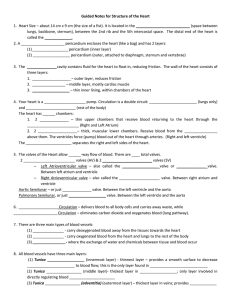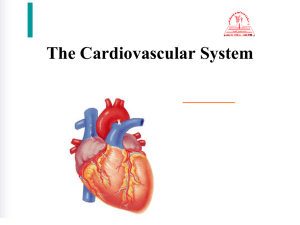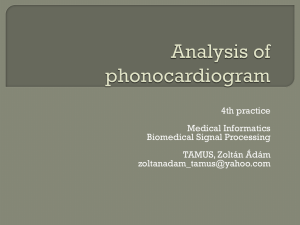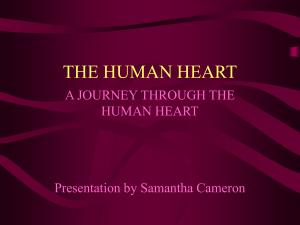LAB #3
advertisement
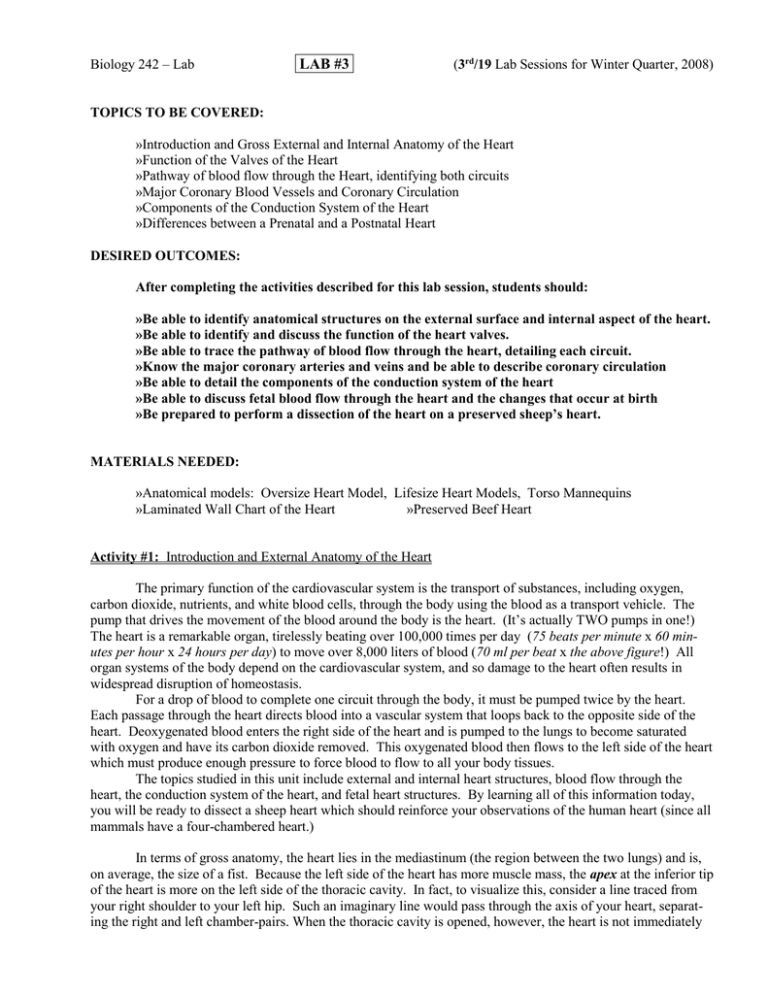
Biology 242 – Lab LAB #3 (3rd/19 Lab Sessions for Winter Quarter, 2008) TOPICS TO BE COVERED: »Introduction and Gross External and Internal Anatomy of the Heart »Function of the Valves of the Heart »Pathway of blood flow through the Heart, identifying both circuits »Major Coronary Blood Vessels and Coronary Circulation »Components of the Conduction System of the Heart »Differences between a Prenatal and a Postnatal Heart DESIRED OUTCOMES: After completing the activities described for this lab session, students should: »Be able to identify anatomical structures on the external surface and internal aspect of the heart. »Be able to identify and discuss the function of the heart valves. »Be able to trace the pathway of blood flow through the heart, detailing each circuit. »Know the major coronary arteries and veins and be able to describe coronary circulation »Be able to detail the components of the conduction system of the heart »Be able to discuss fetal blood flow through the heart and the changes that occur at birth »Be prepared to perform a dissection of the heart on a preserved sheep’s heart. MATERIALS NEEDED: »Anatomical models: Oversize Heart Model, Lifesize Heart Models, Torso Mannequins »Laminated Wall Chart of the Heart »Preserved Beef Heart Activity #1: Introduction and External Anatomy of the Heart The primary function of the cardiovascular system is the transport of substances, including oxygen, carbon dioxide, nutrients, and white blood cells, through the body using the blood as a transport vehicle. The pump that drives the movement of the blood around the body is the heart. (It’s actually TWO pumps in one!) The heart is a remarkable organ, tirelessly beating over 100,000 times per day (75 beats per minute x 60 minutes per hour x 24 hours per day) to move over 8,000 liters of blood (70 ml per beat x the above figure!) All organ systems of the body depend on the cardiovascular system, and so damage to the heart often results in widespread disruption of homeostasis. For a drop of blood to complete one circuit through the body, it must be pumped twice by the heart. Each passage through the heart directs blood into a vascular system that loops back to the opposite side of the heart. Deoxygenated blood enters the right side of the heart and is pumped to the lungs to become saturated with oxygen and have its carbon dioxide removed. This oxygenated blood then flows to the left side of the heart which must produce enough pressure to force blood to flow to all your body tissues. The topics studied in this unit include external and internal heart structures, blood flow through the heart, the conduction system of the heart, and fetal heart structures. By learning all of this information today, you will be ready to dissect a sheep heart which should reinforce your observations of the human heart (since all mammals have a four-chambered heart.) In terms of gross anatomy, the heart lies in the mediastinum (the region between the two lungs) and is, on average, the size of a fist. Because the left side of the heart has more muscle mass, the apex at the inferior tip of the heart is more on the left side of the thoracic cavity. In fact, to visualize this, consider a line traced from your right shoulder to your left hip. Such an imaginary line would pass through the axis of your heart, separating the right and left chamber-pairs. When the thoracic cavity is opened, however, the heart is not immediately visible because it is encased in a secondary cavity called the pericardial cavity. This cavity is formed by the pericardium, a serous membrane. (Recall from last quarter, that all serous membranes are double, that is, they have two reflections: the parietal reflection which lines the cavity’s walls and the visceral reflection which covers the organ(s) located within the cavity.) 1. Refer to Figure 12.7 in the Atlas: The Fibrous Pericardium is the tough, outer layer that anchors the heart to the surrounding structures of the mediastinum. It lacks elastic fibers and therefore is not very distensible, which prevents the heart from overfilling. Intimately attached to its inner surface is the parietal pericardium, whose cells secrete the serous pericardial fluid. When one removes the heart from the chest, the fibrous pericardium (along with the parietal pericardium) stays in the body and thus is absent from an isolated specimen. 2. The Visceral Pericardium covers the surface of the heart; and its cells, too, secrete the serous pericardial fluid that acts as a lubricant to reduce friction during muscular contraction and relaxation. (To help you visualize the relationship between the parietal and visceral pericardial layers, imagine pushing your fist into a loosely inflated latex balloon. The latex of the balloon around your fist represents the visceral pericardium, and the rest of the latex represents the parietal pericardium. The space inside the balloon is the pericardial cavity - which is not “real space”, but rather a very thin area in which the serous pericardial fluid is located.) Another name for this visceral reflection of the pericardium is the epicardium. 3. Once the heart is excised from the chest, it no longer has its parietal / fibrous pericardial layer; but rather one sees the heart wall itself as the external-most structure. The heart wall is organized into three layers: the epicardium, myocardium, and endocardium. Remember, the epicardium is the same structure as the visceral pericardium. The myocardium is composed of cardiac muscle tissue and constitutes most of the heart wall. Deep to the myocardium is the endocardium, a single layer of simple squamous epithelial tissue lining the chambers of the heart – which is not only continuous with, but is the same tissue: endothelium that lines all the blood vessels. (Recall that an endothelium is simply an epithelial tissue layer that forms an innermost lining; and the endocardium is simply the endothelium of the heart!) Now, by following along with the next several pages, your Instructor will demonstrate all the external anatomical structures of the heart including: R and L auricles; external views of the 4 chambers of the heart; sulci – including the coronary sulcus, the anterior interventricular sulcus and the posterior interventricular sulcus (all of which are the outward manifestations of the septae within the heart); base, top, apex, anterior / posterior orientation; the great vessels which enter into and exit from the heart; and the coronary arteries, veins and coronary sinus. Then, it will be your turn for you and lab partners at your table to locate these same structures. Activity #2: Heart Valves To control and direct blood flow, the heart has four valves, arranged in two pairs. One pair of valves are the cuspate valves, aka atrioventricular (AV) valves. The other pair of valves are the semilunar valves. The names of these pairs of valves are based upon the shape of the leaflets that comprise the valves themselves: either cusp-shaped (aka pointed) or half-rounded (aka semilunar). We will first discuss the cuspate valves, aka atrioventricular valves. Each of these valves is located between the atrium and the ventricle on each side of the heart. These valves prevent blood from reentering the atria when the ventricles contract. The right atrioventricular valve has three cuspate leaflets (flaps) and thus is called the tricuspid valve. It can also be called the right atrioventricular valve (RAV) valve. The left atrioventricular valve has two cuspate leaflets and thus is called the bicuspid valve. It can also be called the left atrioventricular valve (LAV) valve; or it can be called the mitral valve (for reminding early anatomists of the Pope’s headpiece called a “mitre”.) You will note in pictures and diagrams that the cusps of each AV valve have small cords, the chordae tendineae, which are attached to papillary muscles on the floor of the ventricles. When the ventricles contract, the leaflets of the AV valves are prevented from refluxing back up into the atria by the papillary muscles pulling on the chordae tendineae. The combination of this “pull downward” and the increased pressure of the blood in the ventricles as they go through systole, keeps the AV valves closed. Note, too, that the Chordae attach everywhere EXCEPT to the cusp-tip of each leaflet. It is these “free” pointed cusp-tips that “slap together with” those of the other leaflets to make the sounds that are associated with the normal, beating heart. (The first heart sound corresponds to the “snapping shut” of the leaflets of the two AV valves; and the Second heart sound corresponds to the “snapping shut” of the leaflets of the two semilunar valves. More on heart sounds in 250 Lecture!) The other pair of valves are the pulmonary and aortic semilunar valves located at the base of each great vessel from which they derive their names. Semilunar valves are composed of three small leaflets and prevent backflow of blood into the ventricles when the ventricles are relaxed (in diastole). Figure 20.6a/b in the Tortora textbook illustrates the function of the AV and the semilunar valves. When a ventricle contracts, in a phase called ventricular systole, pressure forces the AV valve closed. To keep this valve from reversing like an umbrella in a strong wind, the papillary muscles contract and pull on the chordate tendineae to secure the cusps. Increased pressure then forces the semilunar valve open and blood flows into the arterial great vessel associated with that ventricle: into the pulmonary trunk from the RV and into the aorta from the LV. During ventricular diastole, the relaxation phase of the ventricle, blood flows from the atria into the relaxed ventricles through the open AV valves. Note, in the figure, that the papillary muscle and the chordae tendineae are relaxed. The semilunar valve is closed to prevent backflow of blood from the artery into the ventricle. Just as a helpful study tip, remember this “rule of thumb”: the AV and semilunar valves generally work in opposition. When one pair of valves is open, the other pair is closed or is preparing to close. If the atrioventricular valves are open, for example, the semilunar valves are closed. Activity #3: Pathway of Blood Flow Through the Heart As a double pump, the heart delivers blood into two circulatory pathways. Each pathway begins in a ventricle which delivers blood into a series of arteries, capillaries, and veins and then concludes with the return of blood to the atrium opposite the initial ventricle. The two circulatory pathways referred to are the pulmonary circuit and the systemic circuit. Let’s trace a drop of blood through the heart as each of these pathways is discussed: The pulmonary circuit directs deoxygenated blood to the lungs for conversion to oxygenated blood. The right ventricle (RV) receives the deoxygenated blood and pumps it into an arterial great vessel called the pulmonary trunk (just past the pulmonary SL valve) which conducts it to the capillaries of the lungs for oxygenation. Four pulmonary veins drain the lungs and return the oxygenated blood to the left atrium (LA). Blood from the LA (passes through the bicuspid valve and) enters the left ventricle (LV) for a forceful push into the systemic circuit which directs oxygenated blood to all the organ systems for delivery of its “cargo” of lifesustaining O2. The LV pumps oxygenated blood (through the aortic SL valve) into the aorta which conducts blood to all major systemic arteries of the organ systems. After flowing through the capillaries of the organs, deoxygenated blood is returned to the right atrium (RA) via the venae cavae (Superior and Inferior Vena Cava or via the Coronary Sinus). Finally, blood passes from the RA into the RV via the tricuspid valve, and the the full “round trip” is complete for our little drop of blood. Do you agree that: blood passes through the heart twice: the right ventricle pumps it to the lungs and then the left ventricle pumps it to the body tissues. Listing all structures along this “double circuit” in a schematic format looks like this: SVC -O2 blood IVC RA → Tricuspid → RV → Pulmonary →Pulmonary → Pulmonary → Lungs valve SL valve Trunk Arteries +O2 blood Capillaries of ← Major arteries off ← Aorta ← Aortic ← LV← Bicuspid ← LA Organ Systems of the Aorta SL valve valve Activity #4: The Major Coronary Blood Vessels and Coronary Circulation Additional structures of the heart that will be examined are the vessels of the coronary circulation (see Figure 12.3 in the your Atlas). A common misconception is that the heart requires no blood vessels of its own, as it contains blood within its chambers! The nutrients in blood, however, would not be able to diffuse far enough down to nourish the myofibers of the myocardium; and the chambers on the right side contain only deoxygen- ateed blood, which is depleted of oxygen and nutrients. Therefore, the heart necessitates its own set of blood vessels, which together are known as the coronary vessels. Two coronary arteries (the Right and Left Coronary Arteries) branch off the base of the aorta, immediately superior to the aortic semilunar valve, to serve the myocardium. The coronary arteries are drained by a set of coronary veins, which drain into a common vessel on the posterior aspect of the heart called the coronary sinus, which in turn drains into the base of the right atrium. When a coronary artery is blocked, the reduced blood flow to the myocardium can result in hypoxic injury and death to the tissue, termed a myocardial infarction (aka heart attack). When we dissect the sheep’s heart, you will have the opportunity to examine the base of the aorta and identify the R and L coronary arteries which branch off and penetrate the myocardium to its outer heart wall. The RCA follows the coronary sulcus, a groove along the right atrium, to its anterolateral-most extent, where it bifurcates into the acute marginal artery directed anteriorly, and the posterior inerventricular artery (aka posterior descending artery) going posteriorly. The acute marginal artery supplies lateral portions of the right ventricle. The posterior interventricular artery supplies posterior regions of the myocardium. The LCA branches into two arteries: the circumflex artery and an anterior interventricular artery (aka left anterior descending artery). The circumflex artery follows the left side of the heart and anastomoses with the RCA as it enters the posterior coronary sulcus. The anterior interventricular artery lies within the anterior interventricular sulcus. Cardiac veins collect deoxygenated blood from the myocardium. The great cardiac vein follows along the anterior interventricular sulcus and curves around the left side of the heart. The middle cardiac vein drains most of the posterior myocardium, and the small cardiac vein drains the upper right area of the heart. The cardiac veins merge to form the coronary sinus, situation in the posterior region of the coronary sulcus. The coronary sinus is a large vein that empties into the RA. (Recall, that the RA is the receiving chamber of the heart for ALL venous blood: from areas above the diaphragm via the Superior Vena Cava; from areas below the diaphragm via the Inferior Vena Cava; and, now you know the “rest of the story”, from the heart wall itself via the coronary sinus. …and those are the only three “openings” into the RA: the mouth of the SVC, the mouth of the IVC, and the mouth of the Coronary Sinus. Activity #5: Components of the Conduction System of the Heart Cardiac muscle tissue is unique in that it is autorhythmic, producing its own contraction and relaxation phases. However, these contraction and relaxation phases are influenced by the cardiac plexus of nerves that deliver impulses from the sympathetic and parasympathetic divisions of the autonominc Nervous System. Refer to Figure 12.4 of your Atlas which details the Conduction system of the heart: very specialized cardiac myofibers called nodal cells spontaneously depolarize, that is, they produce and conduct electrical currents to the myocardium which coordinate the heart’s contraction. The pacemaker of the heart is the sinoatrial (SA) node, located where the superior vena cava empties into the upper right atrium. Nodal cells in the SA node self-excite (depolarize and repolarize) faster than other areas of the heart, and thus this group of nodal cells sets the pace for the heart’s contraction. When the SA node “fires”, its wave of excitation spreads laterally over both atria and also obliquely to the next structure in the conduction system of the heart: the AV Node. The atrioventricular (AV) node is located on the lower medial floor of the right atrium/interatrial septum. The SA node stimulates the AV node which in turn spreads the impulse toward the ventricles through the atrioventricular bundle (aka Bundle of His). The atrioventricular bundle passes into the interventricular septum and branches into right and left bundle branches. The bundle branches divide into fine conduction myofibers (aka Purkinje fibers) which distribute the electrical impulses to the cardiocytes throughout both ventricles. To review, the cardiac action potentials propagate through the conduction system in the following sequence and with the following action: (1) SA Node (aka “the pacemaker”) – each action potential from the SA node propagates throughout both atria via gap junctions in the intercalated discs of atrial myofibers; following this action potential, the atria contract. (2) By conducting along atrial myofibers, the impulse reaches the atrioventricular (AV) node and triggers an action potential in those nodal cells. (3) From the AV node, the action potential enters the atrioventricular (AV) bundle (aka Bundle of His). This bundle is the only site where action potentials can conduct from the atria to the ventricles. (Elsewhere, the fibrous skeleton of the heart electrically insulates the atria from the ventricles.) (4) After propagating along the AV bundle, the action potential enters both the right and left bundle branches. These two bundle branches extend through the interventricular septum toward the apex of the heart. (5) Finally, the conduction myofibers (aka Purkinje fibers) rapidly conduct the action potential from the apex of the heart upward to the remainder of the ventricular myocardium. Now, the ventricles contract, pushing the blood upward toward, then through, the semilunar valves into the arterial great vessels: into the pulmonary trunk on the right and into the aorta on the left. Activity #6: Differences between a Prenatal and a Postnatal Heart A fetus receives oxygen from the mother via the placenta, a vascular organ that connects the fetus to the wall of the meotehr’s uterus. During development, the fetal lungs are filled with amniotic fluid, and for efficiency some of the blood is shunted away from the fetal pulmonary circuit by several structures. Please refer to Figure 21.30 in your Tortora textbook which highlights these various structures. The foramen ovale is a “hole” in the interatrial septum. Much of the blood entering the right atrium from the inferior vena cava passes through the foramen ovale to the left atrium and avoids the right ventricle and pulmonary circuit. Some of the blood that does enter the pulmonary trunk may bypass the lungs through a connection with the aorta, the ductus arteriosus. At birth, a flap on the left atrial side folds over the foramen ovale and closes it; it thus becomes merely a depression on the interatrial wall, called the fossa ovalis. Likewise, the ductus arteriosus has no more blood flowing through it, so it collapses down and becomes merely the ligamentus arteriosum. Three other fetal structures: the ductus venosus, the umbilical arteries and umbilical vein all undergo the same fate as the ductus arteriosus:

